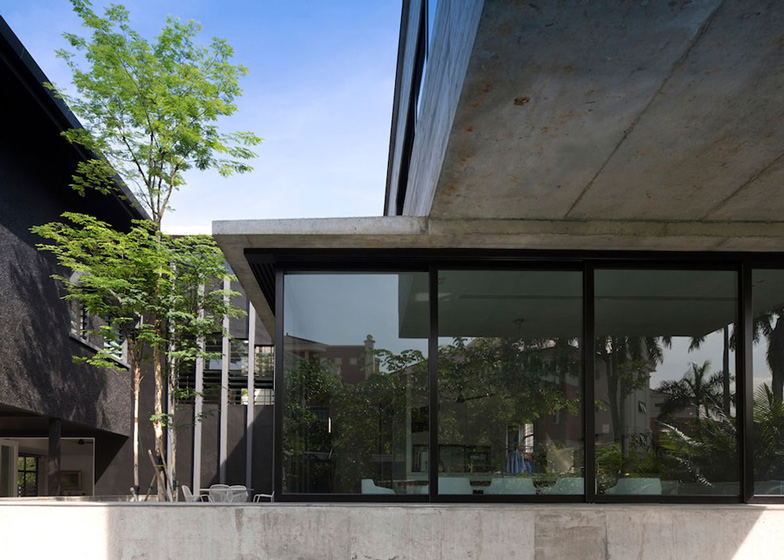A concrete room cantilevers over a swimming pool as part of this extension to a postwar property in Singapore by local office Formwerkz Architects.
The clients asked Formwerkz Architects to extend a two-storey 1970s residence in Singapore's Bukit Timah neighbourhood to give them a multigenerational family home, which is named the Extended House.
The architects designed a new wing at the rear of the plot with a contemporary geometric profile and a exposed concrete exterior that contrasts with the black-rendered plaster finish of the older building.
"From the beginning, we wanted to retain as much of the existing house [as possible], working around it and using it as part of the new narrative," said studio co-founder Alan Tay. "It became a dichotomy of old and new, a story of a recent past and contemporary aspirations."
As well as the new wing, which contains a dining room, kitchen and bedrooms, the architects added a lap pool along one edge of the site and extended the ground floor of the existing building to create a new lounge area.
This extension and a new balcony that projects from the facade of the black building are both finished in the board-formed concrete that creates a clear distinction between the old and new parts of the home.
The cantilevered section contains the master bedroom and extends out towards the pool, shading the decking and the dining room windows below.
An atrium built on the site of the original double-height dining room connects the two wings, while gaps on either side create courtyards sheltered by the long sections of the two main buildings.
The courtyard next to the pool is raised above the level of the decking around it and is bounded by a low concrete retaining wall that provides additional seating space.
A steel mesh bridge inside the atrium traverses the space between the old house and the extension, with concrete walls creating a sense of consistency with the external surfaces. The angled roofline of the original structure can be seen below the level of new windows installed when the atrium was constructed.
Photography is by Albert Lim.
Here's some more information from Formwerkz Architects:
The Extended House
The house at the intersection of Linden Drive and Jalan Naga Sari in Singapore is built for a multi-generational family that entertains frequently. We retained the existing 2-storey post-war bungalow built in the seventies and added a new block at the rear and a lap pool along the side boundary. The new rear extension sits on higher ground than the pool with its upper volume cantilevering over the deck.
From the beginning, we wanted to retained as much of the existing house, working around it and use it as part of the new narrative. It became a dichotomy of old and new, a story of a recent past and contemporary aspirations. The dialogue between the old and new formed the framework for the design. Formally, the new addition is articulated in board-formed concrete volumes in contrast to the existing house in black rendered rough plaster.
The existing high ceiling dining hall is converted to a atrium that bridged the existing house with the new block at the rear. This is the heart of the project where it bridges both physically and spatially, the old house and the new extension.
On the upper floor, a wire mesh steel bridge negotiates the level difference between the existing house and the new extension. The H-shaped massing encloses two intimate courtyard spaces that together with the atrium are spaces of greatest tension between the old and new. The elevated courtyard that fronts the pool has a low concrete retaining wall that encircle it to serves as both barrier and outdoor seating.
Architect - Formwerkz Architects
Design Team - Alan Tay, Iskandar Idris, Ming Hui, Xue Zhen
C&S Engineer - Portwood & Assocates
Builder - Sinwah-Apac Construction
Site Area - 670 sqm
GFA - 450 sqm
Completed - 2013

